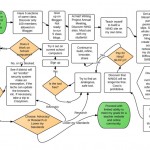The layers of irony in the 1998 film You’ve Got Mail are numerous, but most overt is that the hit-you-over-the-head motif in the film is that the characters all use technology yet smite it. Technology will end society as we know it, despite that the happy ending only arrives due to the use of AOL’s Email (the original online “like” – “You’ve Got Mail!”). The film is a period piece full of things that make us chuckle today including Starbucks only selling hot beverages, and a cash-only line in a grocery store because credit cards were too complicated, and, thus, must be relegated to specialist cashiers. The film was released on VHS but drips with criticism of modern technology. Oh, how far we have come.
I suppose the lessons here are society did not collapse in the 90’s due to dial-up modems, and neither will it under the pressure of smartphones 22 years later. It seems we are all “Digital Citizens” whether we are paying with digital currencies, flirting with emojis, or engaging in academic discourse via blog posts.
I first learned about the term “Digital Citizen” from LeeAnn Lindsey on her featured episode of 3 P’s in a Pod: Season 5 Episode 4 I also follow her on twitter (@SundevilLeeAnn), have read her blog, and enjoyed a presentation at Arizona K-12 Center’s 2019 Teacher Leadership Institute. I will not attempt to summarize her lessons and message — you can explore her work for yourself (which I recommend) — but rather, I would like to discuss how being cognizant of teaching and informing Digital Citizens has and should impact my practice as a ninth grade teacher.
During Lindsey’s presentation, when given processing time, my colleagues and I discussed that we would not be raising Digital Citizens if all we used tech for was to collect assignments and issue quizzes. That would be students complying with our digital barrier, but not necessarily developing their own skills.
Many teachers agree we are educating students not merely in our content but to be capable citizens ready to engage in their community in meaningful ways. The difference between the older generations (am I actually about to lump Millenials in with “older generations?”) and students in school today, is digital technology is not a new thing for them. They did not have to choose to embrace or engage with technology – it is just part of their life. Today’s students were born immersed in a digital world making them “Digital Natives.” Because of this reality, it would be easy for teachers to take for granted that the kids are more tech-savvy than we are.
As a ninth grade teacher, I am here to tell you: kids today may have a screen always accessible, they may never take headphones out, and perhaps they can have whatever they want in minutes thanks to Siri or Alexa, but that does not make them more adept in the digital landscape.
When I began teaching this was shocking to me, and I slowly began implementing explicit technology lessons to gain access to my content. For example, as an English teacher, students inability to type as quickly, or format on a word processor affects the projects we are working on.
Often, students beg me to let them type their essays on their phones. They swear it is faster on their phone. What I have realized is that they are right, but not for the reason they want to hear. Ninth graders can type faster on their phones than a keyboard. However, that’s only because no one has taught them to actually use a keyboard.
Beyond my own anecdotes, a number of studies have been done concerning typing speed. For instance, IBM conducted a study showing the average typing speed on a mobile device is 33 WPM. Cambridge University found that average to be 38. Both studies also point out that this is faster than student will type on a ten-finger keyboard. The Cambridge study also noted that the number of people typing upwards of 100 WPM on a keyboard is decreasing in our population. So perhaps, our digital society may be crumbling if no digital teachers arrive to shepard the youth?
The fastest smart phone typing speed I saw credible evidence of was 88 WPM… Which, while decent, is 1) an anomaly and 2) significantly slower than the speed capacity of ten-finger keyboards. The typing world record actually belongs to Stella Pajunas, who set the record in 1946 on TYPEWRITER. Her speed was 216 WPM.
I was prepared to lay out a full analysis of typing-centric professions (average WPM: 93), and professions seldom using word process (average WPM: 60). I was ready to explain how smartphone typists (average WPM: 35.5) are under-prepared, but my gut tells me none of you need that full breakdown; you already get it.
Does my romantic ideals of what I would be teaching in my literary-analysis-centered classroom include home row key posture, the purpose of the ‘PrtScn’ button, how to attach documents in an email, how to embed a video in a slide show, or how to add paper to a printer? No. But is that my job? Absolutely. Further, I posit it is my job to expose them to, and directly teach them about technology, and digital resources even when it isn’t to perform English tasks.
Of course, I do more than those few things; in fact, I often pause and wonder how I can add a technological or digital layer to an assignment. Because, yes I teach students all of my state and district ELA standards, but if my objective if truly to raise responsible and capable citizens, I have to be raising Digital Citizens.
Because in 2020, all citizens are Digital Citizens.
Starbucks started selling iced-beverages, grocery stores stopped segregating credit card users, and we stopped waiting until we got home to check our Email. The world is a different place than it was in 1998. We must embrace our roles in the present, and help our students flourish.
What ways do you implement technology in your classroom that engender digital growth in students? Share in the comments below!










Comments 1
I LOVE THIS BLOG!!! You are spot on that our students may be “digital natives” but they are not adept in all of the skills needed to thrive in a digital world. We must ALL embrace our roll as educators to develop digital citizens in our classrooms regardless of subject area or developmental level.